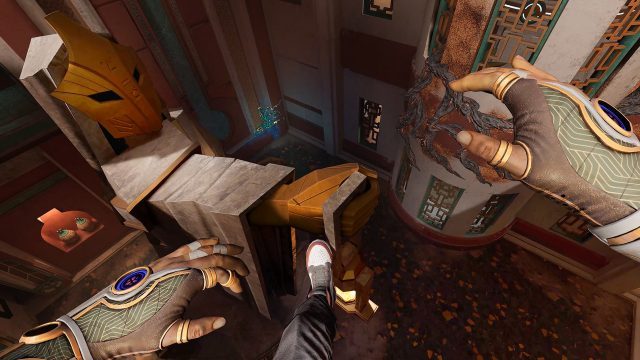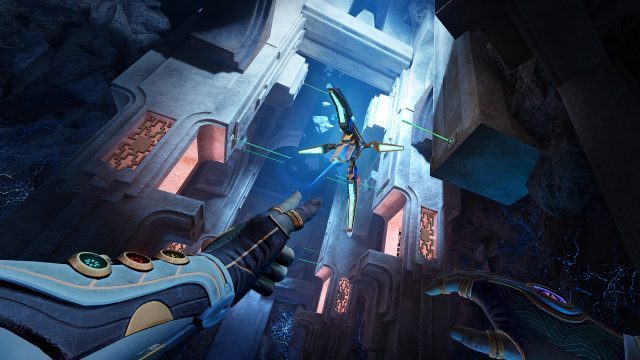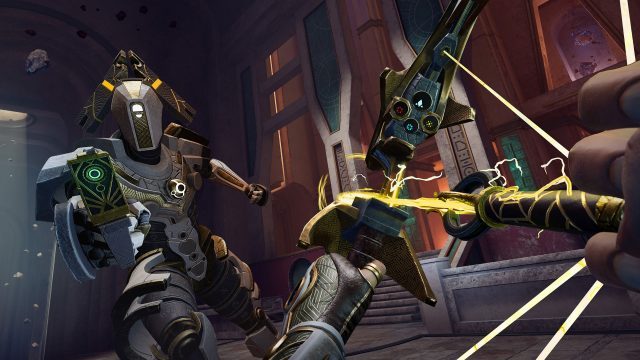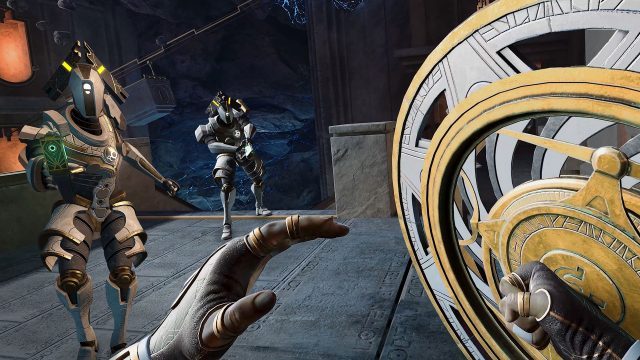Reach is a VR action-platformer from nDreams that aims to let players run, jump, and slide in a way that most VR games intentionally avoid. Does the game’s movement gel well with combat and puzzles? Read our full review to find out.
Reach Details:
Developer: nDreams
Available On: Quest 3 & 3S, PC VR, PlayStation VR 2
Reviewed On: Quest 3
Release Date: October 16th, 2025
Price: $40
Gameplay


As an action-platformer, Reach is about two core things: movement and combat.
On the movement side, Reach feels great. The game combines tried-and-true VR climbing gameplay with a small tweak to jumping that makes a big difference to how the game feels.
Rather than just pressing ‘A’ to make your character leap into the air, you instead need to hold the ‘A’ button and do an arm-raising gesture (as if you’re swinging your arms up for some extra momentum before a leap). It might seem like a small tweak, but it feels more natural and immersive. You can even do the motion with alternating arms to make jumps in quick succession, which I found fun (although the game didn’t seem to explicitly build around it).


Between jumping, climbing on handholds, and using a grapple tool that you get a bit later in the game, I felt like I had a ton of freedom and control over my movement, all while feeling quite comfortable throughout. That is… until the spinning platforms appeared. More on that in the Comfort section below.
Then of course there’s the other core part of the game: combat.


While the movement feels well-executed, combat design feels somewhat scattered. Perhaps most unfortunately, it doesn’t synergize particularly well with the movement.
Core to the combat issue is the player’s weapon. It’s a bow which has several special arrow types. It’s fun to use, but as a two handed-weapon, the player has no access to any of their movement abilities except walking or running on flat ground. A system of slow-motion—activated by drawing the bow while the player is in mid-air—could have been an alluring mechanic to allow players to weave bow shots into their movement.
But limiting the player’s access to movement during combat isn’t the only reason why a two-handed weapon is an odd choice in Reach.
In addition to fun movement, the game also allows players to grab onto walls to pull themselves in and out of cover (used to great effect in two other nDreams games: Fracked [2021] and Synapse [2023]). But… you can’t really use the cover system effectively while also using a two-handed weapon like a bow.
And then there’s the shield which the player can throw, Captain America style. It feels fun to summon, throw, and recall… but once again: a shield takes one hand to use, meaning you can use it in conjunction with a two-handed bow.


The saving grace to the two-handed issue could have been the guns that you can occasionally steal off of enemies. But doing so requires using a rare resource and guns only have three (yes, three) shots before they break. Yes, that limited ammo at least allows the stolen guns to be enjoyable one-hit-kill powerhouses, but it also means you’re quickly back to the bow in your hands which ultimately limits the rest of the game’s combat.
This seemingly small issue (a two-handed weapon as your primary means of combat) unfortunately keeps the game’s combat from really shining by fragmenting the roster of tools that players have to work with. I’m truly curious to see what the game would feel like if the player’s main weapon was a one-handed crossbow instead of a two-handed bow.
Between exploring, solving puzzles, and fighting, there’s a lot to like in Reach. But the experience overall felt hampered by weak pacing. The rate at which new concepts, mechanics, weapons, and enemies are revealed felt too slow, like the game was being stretched out for the sake of length.
Reach took me about seven hours to beat, which included finding most of the hidden upgrades and roughly half of the hidden collectibles. That length sounds pretty good for a $40 game, but better pacing would have made for a more enjoyable experience even if it meant a shorter game.
Immersion


Combat may not have reached its full potential in Reach, but the game has undeniably strong VR fundamentals which help significantly with immersion.
Almost every part of the game (except tutorial and objective pop-ups) feels natively designed for VR. Your map, for instance, can be projected into your hand by raising your palm and holding the trigger. Elevators aren’t activated with a button press but with a big floating cube that you pull into place with a satisfying *clonk*. Weapons have ammo indicators built into their design (instead of a number floating in the air). You can do stealth takedowns by sneaking behind an enemy and ripping out their ‘core’. Instead of doors with hinges, every door in the game is a sliding door (which is so much better for VR usability).
And your entire ‘interface’ is built into your gauntlets. Looking at your arms reveals your health, how many special arrows you’re holding, and more.
The entire game feels diegetic at its core—the way every VR game ought to be.
However, outside of key objects, there wasn’t a whole lot of interactivity with the world. There was the rare movable prop, while the vast majority of objects in the game world are static and non-interactive. And while the environmental art direction was strong, running through so many completely static rooms and corridors made the world feel somewhat empty and uninteresting.
The only respite from the many static rooms was the occasional upgrade station you can find by seeking out less obvious pathways and more challenging puzzles. These were fun to hunt, but the upgrades didn’t feel particularly meaningful.
Comfort


Reach was entirely comfortable to me all the way up to the last quarter of the game, right up to the point that they introduced platforming puzzles rotating pillars.
Smooth rotation is perhaps the most common trigger of motion sickness in most people. Using smooth rotating pillars as the core of the game’s most challenging platforming puzzles is… well, it’s just not a smart choice. When a puzzle is built around a mechanic that causes motion sickness, falling back to the ground and knowing you need to climb up all over again feels like actual torture.
I didn’t need to play with vignette for any of Reach until I got to the rotating pillar puzzles. After attempting the first rotating puzzle I was immediately uncomfortable enough that I needed to take the headset off and come back a few hours later. When I returned to the game I turned on the vignette setting which saved me from quitting the game outright, but still didn’t fully prevent some discomfort.
I expect that enough people who play the game will get motion sick from the rotating puzzles that nDreams ought to have an accessibility option which simply removes them from the game, or offers a way to skip them.
One other notable comfort issue with the game was also an issue of smooth rotation: the game attempts to auto-rotate the player to face some particular direction when they’re climbing sideways or around corners. Again, forced smooth rotation is simply not comfortable for many people. After playing the game for sessions of an hour or so, I had a lingering sense of slight rotations in real life that I’ve never felt after playing any other VR game. I would have happily switched this auto-rotation option off, if the game had bothered to offer a toggle.
‘Reach’ Comfort Settings – October 16th, 2025 |
|
Turning |
|
| Snap-turn | ✔ |
| Quick-turn | ✔ |
| Smooth-turn | ✔ |
Movement |
|
| Teleport-move | ✖ |
| Dash-move | ✖ |
| Smooth-move | ✔ |
| Arm Swing-move | ✖ |
| Blinders | ✔ |
| Head-based direction | ✔ |
| Controller-based direction | ✔ |
| Swappable movement hand | ✖ |
Posture |
|
| Standing mode | ✔ |
| Seated mode | ✔ (not explicit) |
| Artificial crouch | ✔ |
| Real crouch | ✖ |
Accessibility |
|
| Subtitles | ✔ |
| Adjustable difficulty | ✖ |
| Two hands required | ✔ |
| Real crouch required | ✖ |
| Hearing required | ✖ |
| Adjustable player height | ✖ |
